After experiencing the wild, untamed landscapes of Patagonia and Tierra del Fuego, we’re now heading to Buenos Aires, the cultural heart of Argentina. If you haven’t read Part 1 of our journey yet, click here to explore it!
Buenos Aires
Buenos Aires, often called the “Paris of South America”, blends history, architectural splendor, and vibrant culture. Founded by Spanish explorers in 1536, the city was shaped by waves of European immigrants, especially from Italy and Spain. Today, each neighborhood, from San Telmo’s bohemian charm to Palermo’s buzz and Recoleta’s elegance, offers a unique vibe.
Architecturally, Buenos Aires is a visual feast, featuring colonial churches, Beaux-Arts structures, and colorful houses in La Boca. Along Avenida 9 de Julio, one of the world’s widest avenues, stands the iconic Obelisk, while the magnificent Teatro Colón reflects the city's passion for the arts.
Buenos Aires is also the heart of Argentina’s cultural scene. The city pulses with the rhythms of tango, a passionate dance born here in the late 19th century. In La Boca and San Telmo, you can watch traditional tango performances on the street or at historic dance halls. Art lovers can dive into the rich array of galleries, museums, and theaters showcasing both local and global talent.
Beyond its arts and architecture, Buenos Aires is a culinary hotspot. Argentine asado (barbecue) is a must, complemented by world-renowned Malbec wine for an unforgettable taste of the city.
Best Time to Visit: For the ideal Buenos Aires experience, plan your trip in spring (September-November) or fall (March-May). During these seasons, you can enjoy comfortable temperatures and avoid the hot, humid summer or the chillier winter weather.
Places of interest
Buenos Aires is filled with fascinating neighborhoods, historic sites, and cultural landmarks. Here are some top places of interest to experience the city’s unique character:
Plaza de Mayo: This historic square is at the heart of Buenos Aires. Home to the famous pink government building, Casa Rosada, it’s a place steeped in Argentina’s political history.
La Boca: Known for its colorful houses and vibrant street art, La Boca is one of the city’s most iconic neighborhoods. Visit the Caminito street, which is a hotspot for tango dancers and local artisans.
San Telmo: One of Buenos Aires’ oldest neighborhoods, San Telmo is a treasure trove of colonial architecture and antique shops. The San Telmo Market, with its food stalls and unique finds, is perfect for a weekend visit. Sundays bring a lively open-air fair where you’ll see street performers and traditional music.
Palermo: This hip and sprawling neighborhood is known for its parks, stylish boutiques, and vibrant nightlife. Palermo Soho is filled with trendy cafes, designer shops and some of the city’s best restaurants and bars.
Recoleta: Famous for the Recoleta Cemetery, where you’ll find the ornate mausoleums of Argentina’s most prominent figures, including Eva Perón. This upscale neighborhood is home to the Museo Nacional de Bellas Artes, showcasing impressive Latin American art and beyond.
Puerto Madero: A modern waterfront area where old port warehouses have been transformed into chic restaurants and bars. It’s a fantastic place for a stroll, with the iconic Puente de la Mujer (Woman’s Bridge) and a nature reserve offering a peaceful escape from the bustling city.
Teatro Colón: One of the world’s most beautiful opera houses, Teatro Colón is known for its incredible acoustics and stunning architecture.
El Ateneo Grand Splendid: Once a theater, now a bookstore, El Ateneo Grand Splendid is a stunning blend of culture and architecture.
Tip: The fastest and most convenient way to travel between neighborhoods is by using Uber, which is very affordable (around $2-3 USD for an average 20-30 minute ride).
Itinerary
We spent 5 days exploring Buenos Aires, which gave us enough time to see the city’s most important neighborhoods and landmarks, as well as to relax and experience daily life here. Since Buenos Aires is such a vast city, I’ve put together a suggested itinerary below to help you explore its key sights, with each day dedicated to a different area!
Day 1: The Center & Puerto Madero
Start your day with a scenic stroll or bike ride through Puerto Madero, making a loop around the dikes or venturing into the Reserva Ecologica Costanera Sur, a peaceful nature reserve nearby. Along the way, you’ll find plenty of cafes and restaurants for a coffee or lunch break. Don’t miss the striking Puente de la Mujer, designed by renowned Spanish architect Santiago Calatrava. Its unique shape is said to represent a couple dancing tango, making it one of the city’s most iconic sights.
From Puerto Madero, head to Plaza de Mayo in the Microcentro district. Here, you can admire the famous Casa Rosada, where the president’s office is located, and the Cabildo, Buenos Aires’ historic town council building. If you climb to the second-floor balcony, you’ll get a wonderful view of the plaza. The Cabildo also houses a small historical museum, though note that all exhibits are in Spanish. Close by, you’ll find the imposing Centro Cultural Kirchner, a former post office turned into a cultural center.
Next, walk up Avenida de Mayo toward the Congreso building. This spectacular structure is located in Plaza del Congreso, which also features “The Thinker”, the famous sculpture by Rodin. Before reaching Congreso, take a short detour to visit Palacio Barolo. This fascinating building offers guided tours in English and Spanish, and from its rooftop, you’ll enjoy breathtaking views over the city. It’s worth checking the tour schedule in advance.
As you continue northward, you’ll come upon the grand Teatro Colón, one of the world’s most renowned opera houses. If you’re interested in the performing arts, I highly recommend checking the schedule and attending a performance—it’s a fantastic experience!
For some shopping, make your way to Galerías Pacífico, a beautiful shopping mall adorned with a stunning painted ceiling. End your day with a visit to Plaza San Martín, where you’ll find the impressive Palacio Paz mansion.
Day 2: La Boca & San Telmo
Begin your day in La Boca, one of Buenos Aires’ most iconic neighborhoods. Walk through El Caminito, a street filled with colorful houses, street art, and tango performers. For art lovers, visit Fundación Proa, a contemporary art museum showcasing rotating exhibits and don’t miss the rooftop café for panoramic views of the area. While exploring La Boca, stick close to El Caminito and the riverside walk, as other parts of the neighborhood can feel less secure.
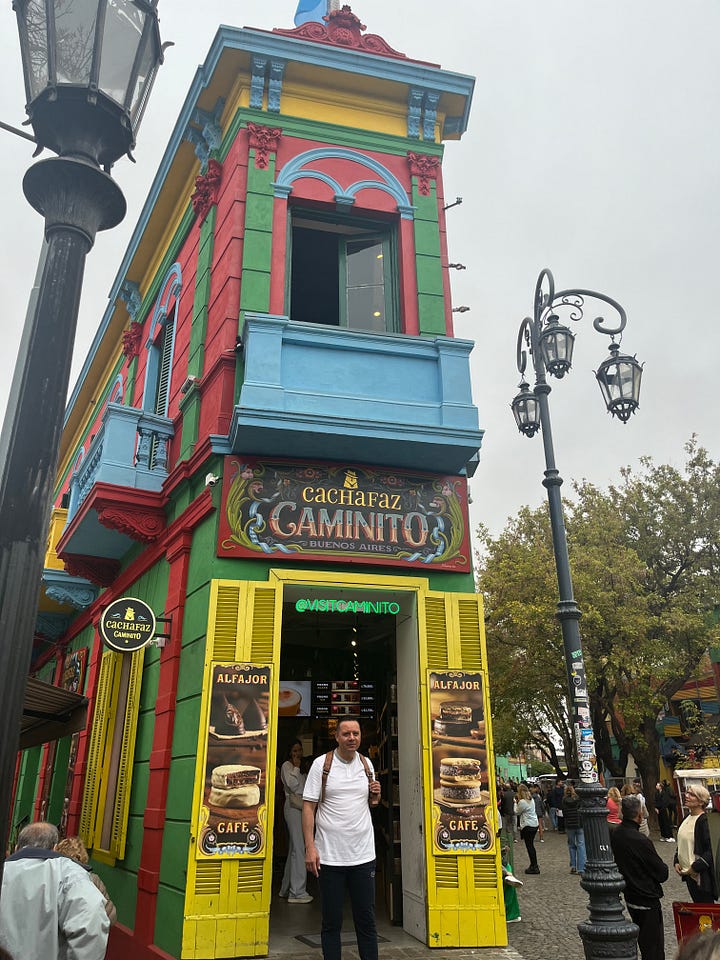
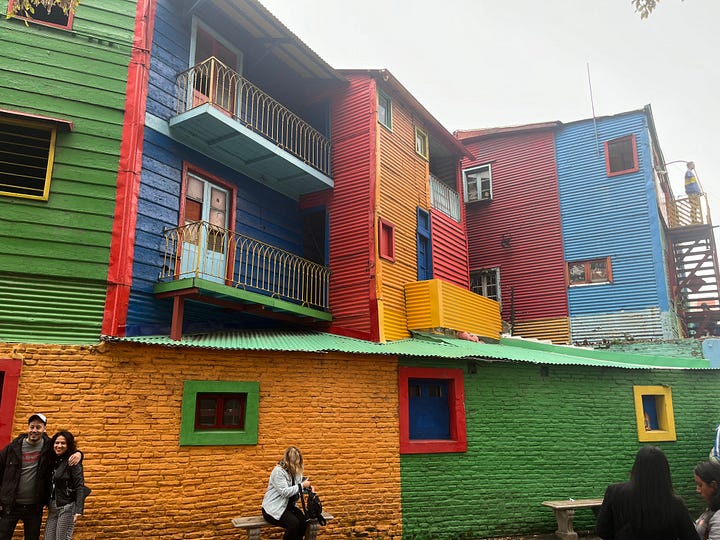
From La Boca, head to the Museum of National History (Museo Histórico Nacional) in the San Telmo area. This museum offers insights into Argentina’s past, featuring artifacts from the colonial and independence eras.
Spend the rest of your day in San Telmo, a historic neighborhood known for its cobblestone streets, vintage shops, and artistic vibe. Wander around Plaza Dorrego, the heart of the district, and browse quirky antique stores and local art galleries. The best time to visit San Telmo is on a Sunday to experience the famous Feria de San Telmo - a sprawling street market offering everything from handmade crafts and jewelry to souvenirs and vintage treasures.
Make sure to stop by the San Telmo Market, an indoor market filled with food stalls and shops. Take a break with a coffee or lunch and savor the empanadas from El Hornero de San Telmo - a must-try for an authentic local flavors!
Day 3: Recoleta
Spending a day in the upscale neighborhood of Recoleta is definitely worth it, especially if you enjoy admiring beautiful architecture. Take a leisurely stroll to explore the stunning buildings, each showcasing unique design.
I highly recommend a visit to the Recoleta Cemetery, where you’ll find impressive tombs and statues, each reflecting various architectural styles. To be honest, we weren’t initially keen on visiting the cemetery, but we ended up being thoroughly impressed. While there, you'll also find the tomb of Eva Perón, which, although significant, is less visually striking compared to other monuments in the cemetery.
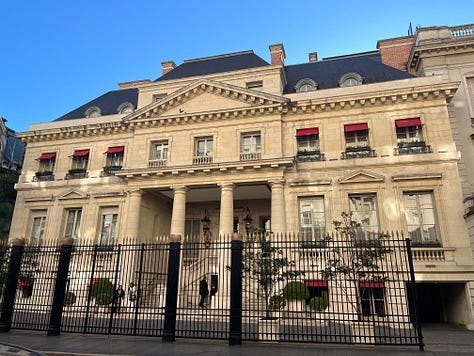
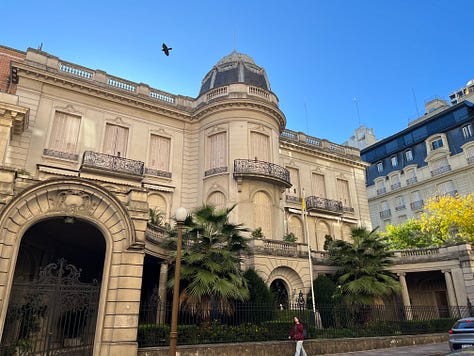
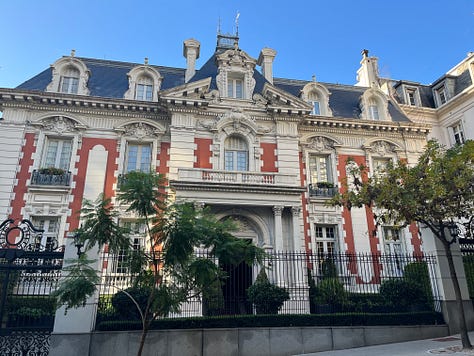
For those interested in shopping, don’t miss El Ateneo Grand Splendid bookstore—ranked among the most beautiful bookstores in the world. Housed in a former theater, this unique spot offers not only an extensive selection of books but also a variety of souvenirs. Another gem worth exploring is Arandu Talabartería, a charming shop selling leather goods and traditional products, almost like a small folklore museum.
If you have even a passing interest in art, the Museo Nacional de Bellas Artes is a must-visit. The entrance is free, and you’ll be treated to a remarkable collection of paintings and sculptures, featuring both Argentine and European artists, including works by Monet.
Day 4: Palermo
Palermo is a very lively neighborhood, both during the day with its many cafes, and boutique shops, and at night with a wide variety of restaurants and bars. During our five days in Buenos Aires, we visited Palermo twice and thoroughly enjoyed its charm!
I’d suggest starting your day strolling through the streets of Palermo Soho, known for its colorful murals and independent shops, perfect for a coffee or brunch. From there, head to the Jardín Botánico, Ecoparque, and Jardín Japonés to enjoy incredible greenery, flowers and even a small zoo. These lush spaces provide a refreshing escape that makes you forget you’re in the heart of a bustling capital city.
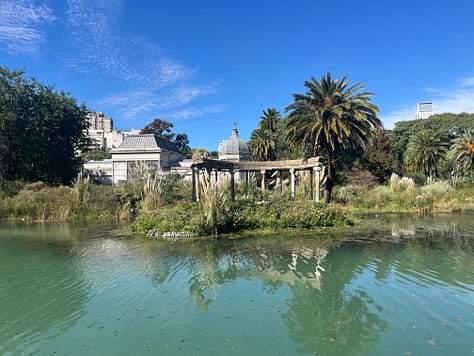
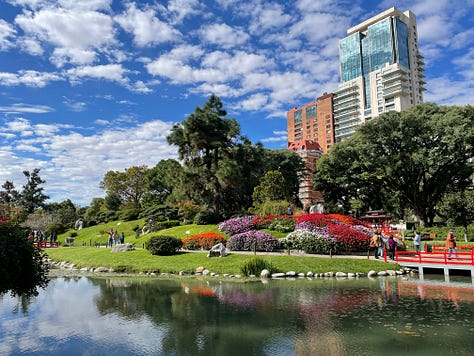
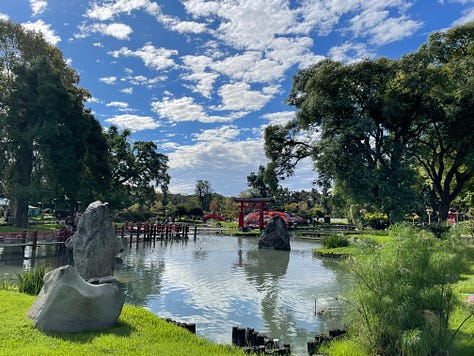
Continue to Parque Tres de Febrero—while it’s the most famous park, I found it less intriguing compared to the others. Afterward, check out the Hipódromo de Palermo, a racetrack with an imposing historic building. We were fortunate to visit on a day when an “asado & empanada” festival was taking place, making it an ideal combination of delicious food and a unique experience watching the races!
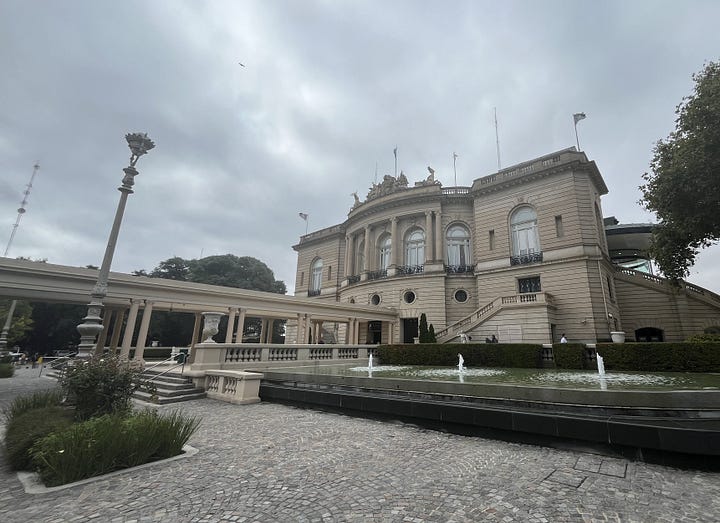
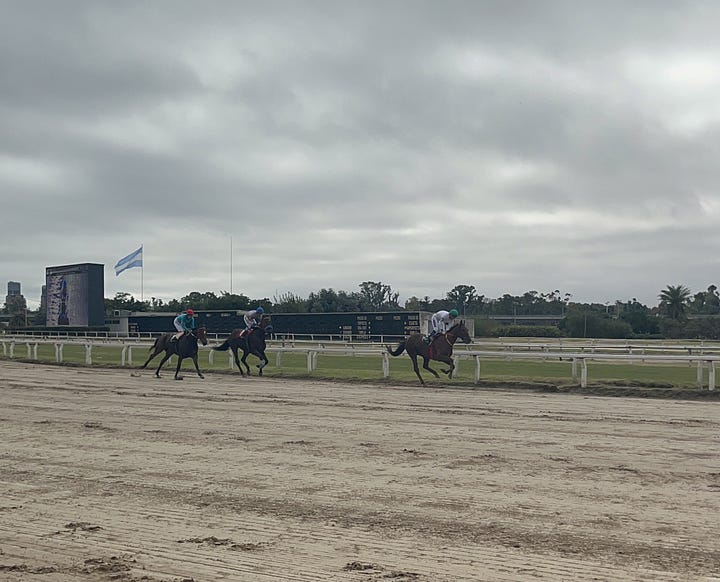
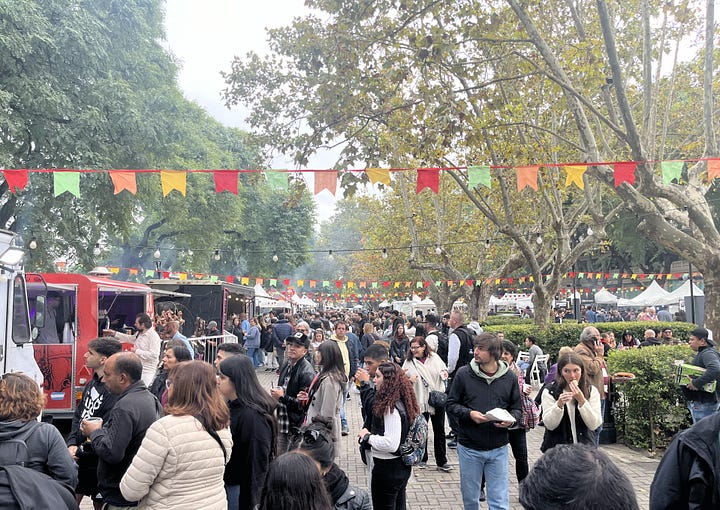
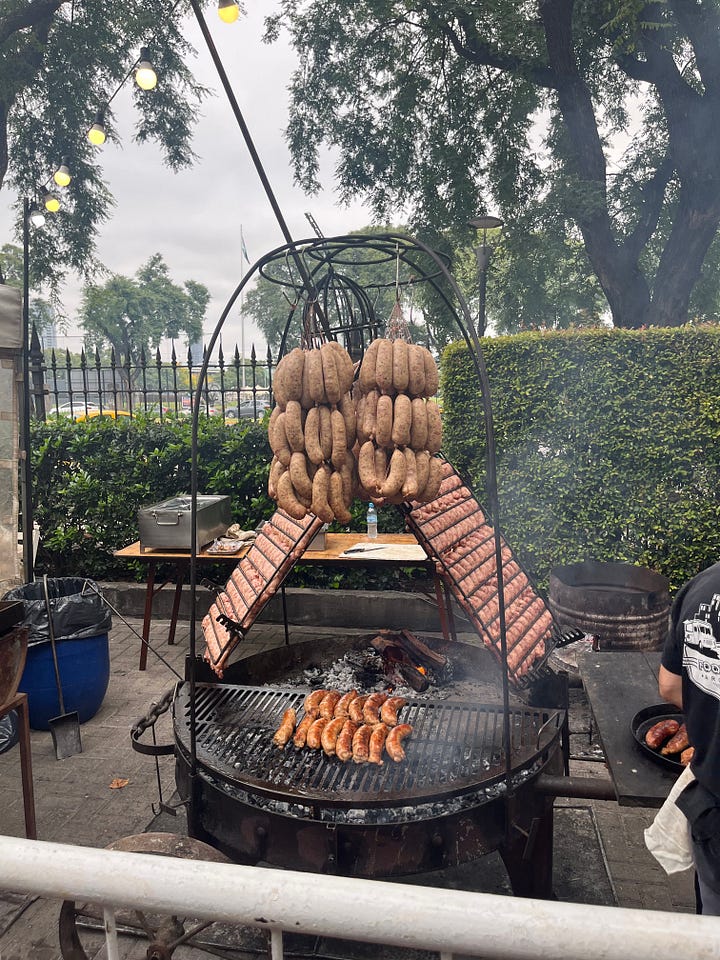
Tip 1: Be ready for a lot of walking to cover all these sites in Buenos Aires, and stay mindful of your belongings! While generally safe, certain areas like Congreso, Microcentro, and La Boca can feel a bit less secure due to occasional pickpocketing. The best approach? Stay low-key, avoid looking overly touristy, and keep your phone tucked away rather than out for photos.
Tip 2: I recommend following the "buenosaires" account on Instagram to stay updated on the latest events, exhibitions, and everything happening in the city - this is how we learned about the outdoor markets and festivals!
If you have extra time, consider spending a day at an estancia for an authentic local experience in the San Antonio de Areco area, though do keep in mind that it can be quite touristy and pricey. Another option is a day trip to Colonia in Uruguay - it’s only an hour away by ferry from Buenos Aires - or to the city of Tigre and its scenic delta region nearby. Alternatively, externd your stay in Buenos Aires - like we did - and you’ll certainly discover plenty of interesting things to do!
Accommodation
Buenos Aires offers a wide range of accommodation options, from cozy Airbnbs to luxurious hotels. For neighborhoods, I’d recommend Palermo and Recoleta—both are safe, well-located, and filled with great dining and entertainment options. Recoleta is slightly closer to many major sights, but with less options for entertainment.
We stayed at the Poetry Building Hotel in Recoleta, which was a solid choice overall. The location was excellent—situated in an upscale and safe area, just a short walk from the main street with plenty of restaurants and shops nearby. The staff was incredibly friendly and attentive, going out of their way to meet our needs. However, the rooms felt a bit dated, so a renovation would make the experience even better!
Food
Argentina is a paradise for meat lovers—like us! In Buenos Aires, you’ll find amazing options for every budget, from casual spots to upscale dining. Here are three standout recommendations, each offering a unique culinary experience:
Don Julio: A renowned high-end restaurant, ideal for dinner, famous for its exceptional meat cuts, outstanding wine list, and impeccable service. It’s a must-visit for a top-tier dining experience. Be sure to book in advance, as it’s extremely popular. While pricier than other options (~$40–50/person), it’s absolutely worth it!
Huacho & Santos Manjares: These casual yet fantastic spots are perfect for lunch or dinner. They offer amazing meat cuts and an affordable wine list, all at a great value (~$20–30/person).
Apart from meat restaurants, we also tried the famous Pizzeria Güerrin. However, it wasn’t quite to our taste, as the pizza was too thick and oily. On the bright side, if you’re in Recoleta, I’d highly recommend stopping by Pot Helados for dessert. Their ice cream is absolutely delicious and worth trying!
Wine bars
Verdot Wine Bar: A classy wine bar inside a boutique hotel with a curated wine list to suit all tastes and budgets. The ambiance is elegant, and the finger food is excellent—we loved the generous and delicious cheese & ham platter. Surprisingly great value for money, it’s perfect for a stylish evening!
Pain et Vin: A charming French-style wine bar with an extensive list, including premium wines served by the glass with "Coravin." Perfect for a wine tasting experience paired with flavorful finger food. While the quality is excellent, portions are small, and prices lean on the higher side.
Coffee
I must admit, we’re true coffee lovers—always on the lookout for excellent artisanal coffee shops, often grabbing a cup to-go as we explore. To our delight, Buenos Aires turned out to be a haven for specialty coffee! We discovered numerous spots serving exceptional brews, and we thoroughly enjoyed the coffee culture. Here are some of our favorites:
Toki Moment - Specialty Coffee: one of the best specialty coffees I’ve ever tried!
Piccolina Cafe & Tonico Cafe: Very nice spots for both coffee & brunch.
Lattente & Borja Specialty Coffee: Ideal for grabbing a coffee to go.
Buenos Aires is a city that effortlessly blends old-world charm with modern vibrancy. From its historic landmarks and colorful neighborhoods to serene parks, along with a thriving culinary scene and the soulful rhythms of tango, it promises unforgettable memories!








Thank you for this great itinerary, the tips and GoogleMap links!!
One of the greatest cities in the world. I live in the BA of the north now, but never pass up a chance to visit. Lovely suggestions. 🌸